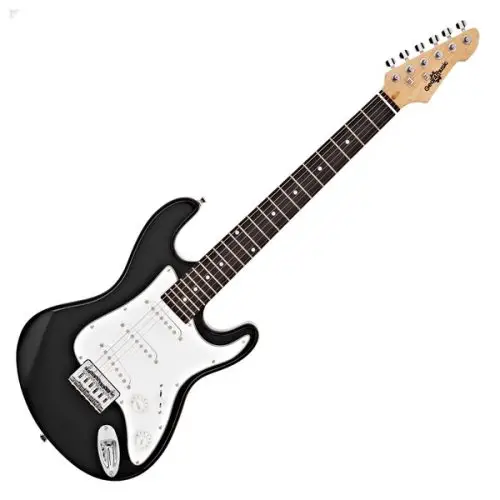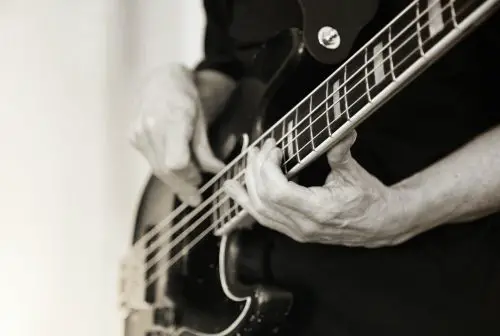The bass guitar is often said to be easy to learn. However, it’s not easy to play it well.
Due to this, it is suggested to learn to play the guitar first (electric or acoustic) because the skills learned on the guitar are easily translated onto the bass. (Bass skills do not translate much to guitar).
I’ve had the pleasure to play and teach both the bass and the electric guitar. I started my musical journey by beginning with the electric guitar. Later on, I picked the bass and learned to play it.
In my experience, learning the guitar first helped me build up muscle memory with chord progressions, while learning the bass helped me build my rhythm.
In this article, I will help you choose your first instrument as a beginner, whether it’s a bass or an acoustic guitar, and discuss why it can be a perfect fit for you. Here are the topics we will cover in this article:
- Which Is Easier Between Guitar and Bass?
- Is It Better to Start on Guitar or Bass?
- Should You Learn Normal Guitar Before Bass?
- Is Bass a Good Starter Instrument?
- Differences Between Acoustic, Bass, and Electric Guitars
- How Do I Choose the Right Instrument?
Which Is Easier Between Guitar and Bass?
Physically, a lot of players find the guitar easier to get into than bass. The bass is a bigger instrument and has thicker strings that many players struggle to fret correctly.
It’s common to think that the bass is easier as it only has four strings, making it easier to master.
However, this isn’t necessarily the case, as both the bass and guitar can be as easy as you want them or as hard depending on the complexity level you want to play at.
It’s fairly easy to look at a few YouTube videos and learn a few chords to get started playing the guitar. However, if you start looking to learn the advanced techniques in guitar playing, it could possibly take years to perfect.
Techniques like barre chords, tapping, shredding, and sweep picking can take years to master, making the guitar a very deep instrument to learn. The guitar does have more strings than bass, which can make it seem challenging.
On the other hand, Bass is fairly easy to get started with as it has only four strings. However, this doesn’t mean that the bass is a shallow instrument.
Like the guitar, the bass also has some advanced techniques like tapping, slapping, vibrato, and sliding, which can take years to master. Bass also requires the player to work on their rhythm, more so than a guitarist, which can be an added challenge for a beginner.
I recommend going for the instrument that seems more appealing to you. Don’t just go for the bass as it has lesser strings.
The bass will help you make your rhythm better, while the guitar will help you learn chords better. You won’t go wrong learning either instrument.

Starting with guitar (electric or acoustic) first is better because most skills and knowledge are transferrable to bass.
Is It Better to Start on Guitar or Bass?
If you want to play both instruments well, it’s best to learn the guitar first but start learning the bass before you go too far into learning the guitar.
The knowledge you gain while learning either guitar translates well into the other. This means that once you start learning the chords, you will know the bass notes you need to play over these chords to make your playing sound fantastic.
Should You Learn Normal Guitar Before Bass?
If your end goal is to play the bass, you don’t need to play the guitar first, as it will only take up time and serve as a distraction.
Instead, focus your learning on the bass, as it will help you become a good bass player more quickly.
By learning the acoustic guitar, you adopt the mindset of melody. However, playing the bass gets you in the mindset of the bass, which is rhythm.

If you are passionate about bass, then starting with bass first is not an issue. You should always play the instrument that interests you most.
Is Bass a Good Starter Instrument?
The bass is the fastest instrument to learn, and you can get from a complete beginner to someone who plays competently in less time than the guitar, piano, or drums.
The bassists play the root notes one at a time. However, a bassist needs to have more rhythm than the others as their job is to keep the rhythm going. This is because guitarists and pianists often learn to play chords of three notes at one time.
Differences Between Acoustic, Bass and Electric Guitars
On the surface, the Bass, Acoustic and Electric guitars may seem very similar in appearance. However, that’s where the similarities end. Here’s a comparison table to help you better understand the differences, and then we will detail each guitar.
| Bass Guitar | Acoustic Guitar | Electric Guitar | |
| Price | ~$600 | ~$100 | ~$400 |
| Difficulty | Easy | Normal | Normal |
| Strings | Thickest | Thick | Thin |
| Number of Strings | 4 | 6 | 6 |
An acoustic is more challenging to play than the electric guitar because of its thicker strings and the added tension. Electric guitars are the easiest to play physically, but they require the most finesse, making it hard for some.
Bass strings are the lowest and the thickest. This means their tension is lower, and they are floppier than guitar strings. Bass frets are much further apart, which makes them easier to fret.
The guitar is easy to get into. Bass guitar is easy to get into, but there is a steep learning curve which makes it easy to learn but tough to master. The advanced techniques can be challenging, but they aren’t extremely hard.
1. Bass Guitar
Bass guitars are 4-string guitars that produce sounds of lower frequencies and are typically used to create the sonic link between the melodic and rhythmic elements in a band.
The bass guitar works similarly to the electric guitar as it produces sound when the metal strings vibrate over a magnetic pickup.
The pickup then transmits a signal which is then processed by an amplifier. This creates the bass, which can be heard by the human ear.
The main difference between the bass and the guitar is that most bass guitars have four strings. The highest first string is tuned to G2 and is called the G string.
The second string is tuned to D2 and is called the D string. The third one is tuned to A1 and is the A string. The lowest fourth string is tuned to E1 and is the E string.
2. Acoustic Guitar
Acoustic guitars are 6-string guitars known to create some of the most melodic and pleasant sounds. The body is hollow, and these guitars are much bulkier.
The sound is created through strumming, which creates vibration in the strings projected through the sound hole.
Acoustic guitars are among the top choice for beginners when looking for a guitar, and for a good reason, they’re fun to play and sound nice even when not being played well.
These are 6-string guitars and can be either steel string or nylon string guitars. Their string thickness lies between the string thickness of bass and electric guitars.
3. Electric Guitar
Electric guitars are 6-stringed guitars that generate their sound using electricity. The body of an electric guitar is thinner as well as the strings. However, the body of the guitar contains electrical components like transducers.
Electric guitars can come in a huge variety of pickup combinations and builds. However, a solid-body electric guitar is the most commonly used. Its metal strings allow the vibrations to be picked up easily, and its solid body design reduces feedback.
An amplifier plays a huge role when playing the electric guitar. Without it, the projected sound won’t sound that good. Like the acoustic guitar, the electric guitar also has 6 strings, and its neck is divided into frets.
How Do I Choose the Right Instrument?
The right instrument between the guitar and bass is what you want to play. You shouldn’t choose one over the other just because it seems easy. Both instruments have their pros and cons.
To choose your first instrument, you need to know your musical goals. Ask yourself, what do you want? Do you want to be the rhythm part of your band, or do you want to create the melody?
If your answer is the latter, you should go for the guitar. Guitar has a much more varied role than bass. Guitar players have much more freedom to go off-script with embellishments and solos.
However, if you’re looking to be a rhythmist, then bass is the choice for you. The bass acts as a bridge between the drums and the guitar. Although the bassist usually sits at the back and does their thing, it’s the bassist’s job to hold the band together and keep them in a rhythm.
In my opinion, don’t choose one over the other just because it may seem easy. Instead, go for the one that you’re passionate about.
Conclusion
In conclusion, the best instrument you choose is the one you want to play. Sure, bass can be easier to get into, but it can be difficult to master due to its steep learning curve.
On the other hand, the guitar requires you to learn chord progressions which can be equally terrifying for some. I hope this article helped you gain more insight into the differences between the guitar and the bass and helped you choose your first instrument as a beginner.






